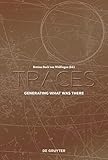Traces : Generating What Was There / ed. by Bettina Bock von Wülfingen.
Material type: TextPublisher: Berlin ; Boston : De Gruyter, [2017]Copyright date: ©2017Description: 1 online resource (122 p.)Content type:
TextPublisher: Berlin ; Boston : De Gruyter, [2017]Copyright date: ©2017Description: 1 online resource (122 p.)Content type: - 9783110534788
- 9783110534832
- 9783110535068
- 571.6 23
- QH604.2
- online - DeGruyter
| Item type | Current library | Call number | URL | Status | Notes | Barcode | |
|---|---|---|---|---|---|---|---|
 eBook
eBook
|
Biblioteca "Angelicum" Pont. Univ. S.Tommaso d'Aquino Nuvola online | online - DeGruyter (Browse shelf(Opens below)) | Online access | Not for loan (Accesso limitato) | Accesso per gli utenti autorizzati / Access for authorized users | (dgr)9783110535068 |
Frontmatter -- Inhalt -- Editorial -- Image Description -- Layers of Operation. Lars Leksell’s Neurosurgical Planning Image -- Description, Experiment, and Model. Reading Traces in Paleobiological Research Exemplified by a Morpho-functional Analysis -- Image Description -- Visualizing Viruses. Notes on David S. Goodsell’s Scientific Illustrations and Their Use in Molecular Biology between Picture Model and Trace -- Microscopic Imaging. Interference, Intervention, Objectivity -- “It is not enough, in order to understand the Book of Nature, to turn over the pages looking at the pictures. Painful though it may be, it will be necessary to learn to read the text.” Visual Evidence in the Life Sciences, c. 1960 -- Giving a Theory a Material Body. Staining Technique and the “Autarchy of the Nucleus” since 1876 -- Interview -- Traces and Patterns. Pictures of Interferences and Collisions in the Physics Lab A Dialogue between Dr. Anne Dippel and Dr. Lukas Mairhofer -- Liquid or Globular? On the History of Gestalt-seeing in the Life Sciences of the Early 19th Century -- Traces of Bodies and Operational Portraits. On the Construction of Pictorial Evidence -- Reduced Complexity or Essentialism? Medical Knowledge and “Reading Traces” in the History of Art -- Image Credits -- Authors
restricted access online access with authorization star
http://purl.org/coar/access_right/c_16ec
Traces keep time and make the past visible. As such, they continue to be a fundamental resource for scientific knowledge production in modernity. While the art of trace reading is a millennia-old practice, tracings are specifically produced in the photographic archive or in the scientific laboratory. The material traces of the forms represent the objects and causes to which they owe their existence while making them invisible at the moment of their visualization. By looking at different techniques for the production of traces and their changes over two centuries, the contributions show the continuities they have, both in the laboratories and in large colliders of particle physics. This volume, inspired by Carlo Ginzburg’s early works, formulates a theory of traces for the 21st century.
Mode of access: Internet via World Wide Web.
In English.
Description based on online resource; title from PDF title page (publisher's Web site, viewed 30. Aug 2021)


